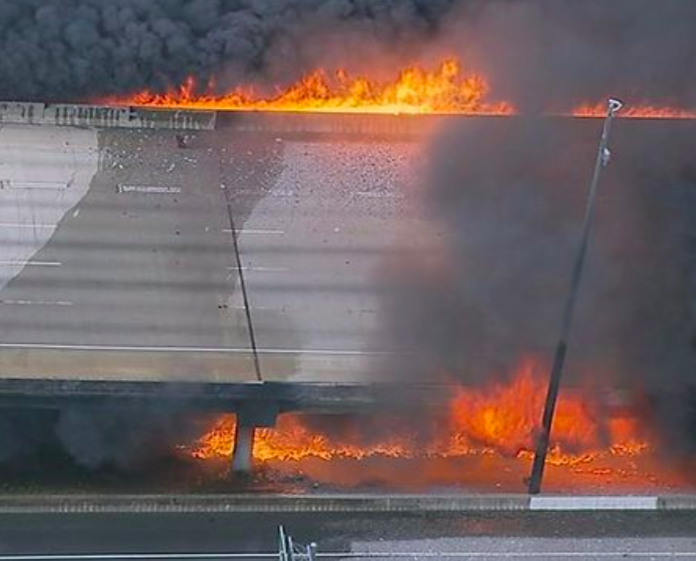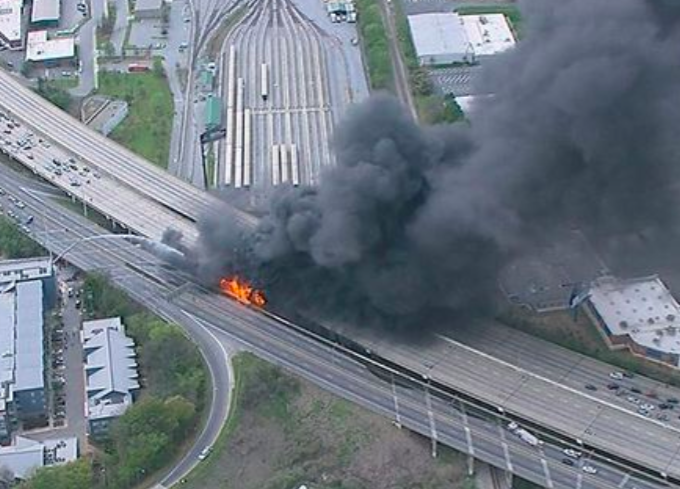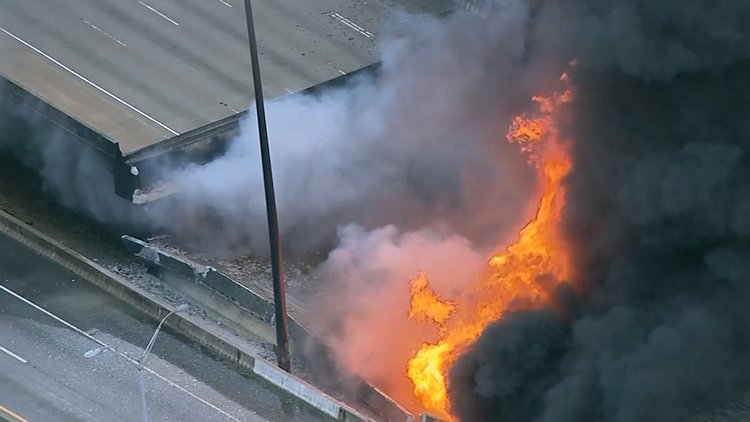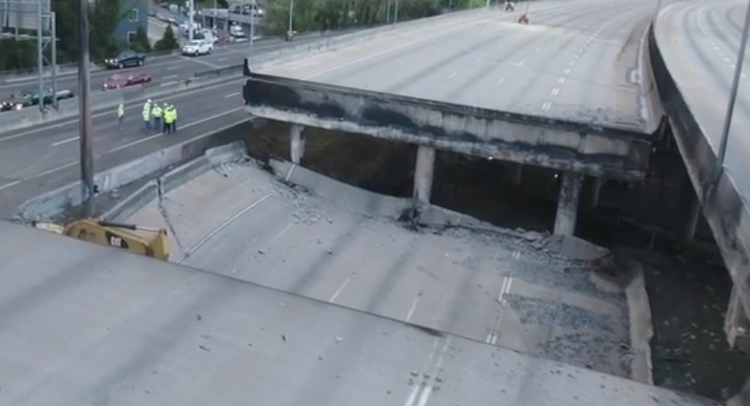- Before and after: Click through the gallery below to see the sequence of collapse.
Even for a city historically linked to fire, the spectacularly intense blaze that brought down a 350-foot-long stretch of I-85 in Atlanta last week was one for the ages. Now, cities across the US are on notice to make sure they don’t accidentally replicate the unique conditions that appear to have triggered the unusual event that will now snarl local traffic for months as area contractors work 24-7 to rebuild the road.
All things considered, the City of Atlanta was extraordinarily lucky that no lives were lost and no one was even injured this past Thursday afternoon, March 30, when a small fire apparently set by a homeless man ignited a nearby cache of construction materials stored under the highway. Investigators are continuing to piece together the sequence of events, but it appears that stacked coils of “high-density plastic conduit” used for cabling and fiber-optic wiring burned at such high temperatures that they weakened the steel and concrete roadway some 20 feet above, possibly in less than an hour.
“Any time you have a high heat source like the interstate fire, you see material properties—especially for steel—degrade,” said Georgia Tech’s Lauren Stewart, PE, an assistant professor focused on hazards engineering for structures, especially fire, blast, and wind. “When fire burns for a long duration, that’s what can happen in buildings and bridges. It’s what happened to the Twin Towers on September 11. As the materials degrade, that weakens the ability to carry loads.”
“We hope, through the joint review and the NTSB investigation, that Georgia and the nation can benefit from the findings”
The intensity of the heat in Atlanta last week, which city fire officials say reached 1,000 degrees, appears to have shortened the duration of time needed to cause such structural damage. As a result, the Georgia Department of Transportation (GDOT) is alarmed enough that it has sent a letter of warning to all 49 other state DOTs to be aware of the potentially disastrous risk of such storage practices. “We expect the statewide review will provide recommendations regarding best practices that will ensure adequate storage and handling of all materials,” said GDOT Commissioner Russell R. McMurry, speaking yesterday at a press conference. “We hope, through the joint review and the National Transportation Safety Board (NTSB) investigation, that Georgia and the nation can benefit from the findings.”
For now, both state and city are focused on reopening the vital transportation link that handles some 250,000 vehicles per day. GDOT Director of Construction Marc Mastronardi (above) this week said that he believes emergency demolition and reconstruction can be completed by June 15. “At the governor’s urging, we are going to incentivize the completion of this work,” Mastronardi said. “We have selected a date that we believe is aggressive but attainable and will offer a bonus for early completion.”
Aggressive, 10-week schedule
Toward that end, GDOT this week hired C.W. Matthews Contracting Co., based in Marietta, GA, to lead the rebuilding effort. To expedite the work, Mastronardi said, the contractor will be retrofitting the bridge columns using concrete that will cure in 24 hours while prefabricating elements of the new bridge.
The I-85 bridge was built in 1953 and last renovated in 1985. It earned a high “sufficiency rating” when last inspected in 2015, according to the Federal Highway Administration. Earlier this week, the US Department of Transportation (USDOT) pledged $10 million in emergency funding to help rebuild it.
Speaking this week to USA Today, consulting engineer Andy Herrmann, a past president of the American Society of Civil Engineers (ASCE), said that “concrete starts to crack at 500 degrees, suffers large cracks at 1,000 degrees, and melts at 2,500 degrees.”
As for the steel, “a 50-foot beam could expand 4 inches when heated to 1,000 degrees,” added Larry Petrick, a deputy director for the International Association of Fire Fighters. After cooling down, the beam loses 50 percent of its strength, he told the Associated Press.
On March 31, Atlanta police arrested three homeless individuals who had been seen under the bridge. One was charged with “arson, first-degree criminal damage to property, and criminal trespass.” The other two suspects were each charged with criminal trespass.





Discussion
Be the first to leave a comment.
You must be a member of the BuiltWorlds community to join the discussion.